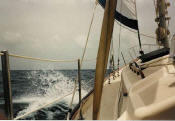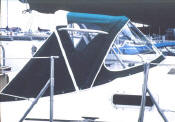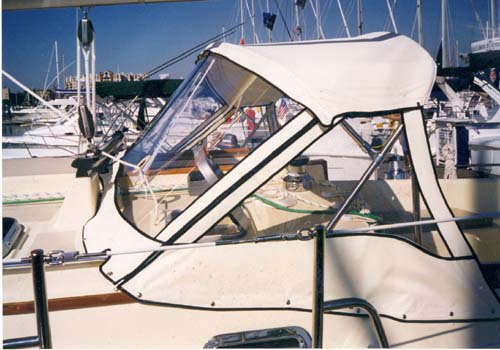 Call 262-835-9100
Call 262-835-9100
Fax 262-835-9102
boattailors@gmail.com
Dodger Options for Sailboat
Function
 The primary function of a dodger is to deflect wind flow and keep spray off the occupants of the cockpit. It is an average of 10 degrees warmer behind a dodger. The Boat Tailors dodgers are designed to take rough seas.
The primary function of a dodger is to deflect wind flow and keep spray off the occupants of the cockpit. It is an average of 10 degrees warmer behind a dodger. The Boat Tailors dodgers are designed to take rough seas.
Our dodgers mount on the cabin top. This normally provides a good mounting surface to secure the dodger. It also determines the width of the dodger. It is wide enough to provide protection for the cockpit but not too wide to get past when going forward.
The dodger must be designed with the sailor in mind. The dodger manufacturer must have a good working knowledge of sailing, rigging and procedures. Our years of experience help us provide the sailor with the least intrusive dodger possible. Our award winning designs have been proven over the years as being a great benefit to those that have them.
Decisions you must make:
Type of dodger:
 Traditional – Primarily for traditional style boats. Limited visibility. Gives a more rounded appearance even with the same frame. Fabric goes from combing to combing over the top of the dodger and windows are cut into fabric. Front windows are removable, but side windows are not.
Traditional – Primarily for traditional style boats. Limited visibility. Gives a more rounded appearance even with the same frame. Fabric goes from combing to combing over the top of the dodger and windows are cut into fabric. Front windows are removable, but side windows are not.
Dodger Options for Sailboat
Function
 The primary function of a dodger is to deflect wind flow and keep spray off the occupants of the cockpit. It is an average of 10 degrees warmer behind a dodger. The Boat Tailors dodgers are designed to take rough seas.
The primary function of a dodger is to deflect wind flow and keep spray off the occupants of the cockpit. It is an average of 10 degrees warmer behind a dodger. The Boat Tailors dodgers are designed to take rough seas.
Our dodgers mount on the cabin top. This normally provides a good mounting surface to secure the dodger. It also determines the width of the dodger. It is wide enough to provide protection for the cockpit but not too wide to get past when going forward.
The dodger must be designed with the sailor in mind. The dodger manufacturer must have a good working knowledge of sailing, rigging and procedures. Our years of experience help us provide the sailor with the least intrusive dodger possible. Our award winning designs have been proven over the years as being a great benefit to those that have them.
Decisions you must make:
Type of dodger:
 Traditional – Primarily for traditional style boats. Limited visibility. Gives a more rounded appearance even with the same frame. Fabric goes from combing to combing over the top of the dodger and windows are cut into fabric. Front windows are removable, but side windows are not.
Traditional – Primarily for traditional style boats. Limited visibility. Gives a more rounded appearance even with the same frame. Fabric goes from combing to combing over the top of the dodger and windows are cut into fabric. Front windows are removable, but side windows are not.
 California – Used both on traditional and modern style boats. Provides a sleeker appearance plus more versatility. Side and front panels are removable. There is also greater visibility because the side windows are bigger.
California – Used both on traditional and modern style boats. Provides a sleeker appearance plus more versatility. Side and front panels are removable. There is also greater visibility because the side windows are bigger.
Currently Boat Tailors does probably 50 to 1 California over Traditional. We have won awards for our designs in both styles, but the California style is the overwhelming choice of sailors.
Height of the Dodger
High Profile Dodger Illustration and Example
Height of the Dodger
 |
 |
Low Profile Dodger Illustration and Example
 |
 |
Relationship of Dodger Height and Design
To check the height desired have the captain(s) stand behind the helm. Then have the first  mate hold a tape measure vertically, just aft of the cabin, measuring from the sole of the cockpit. Have him or her move their fingers up and down the tape while the captain looks forward as if sailing. This simulates the aft bow of the dodger. Be sure that the aft bow is not at eye height. If it higher, then it is a high profile dodger. If lower, so as to look over the dodger, it is a low profile. As the dodger gets lower, access to the companionway is restricted. The illustration will help you determine dodger height.
mate hold a tape measure vertically, just aft of the cabin, measuring from the sole of the cockpit. Have him or her move their fingers up and down the tape while the captain looks forward as if sailing. This simulates the aft bow of the dodger. Be sure that the aft bow is not at eye height. If it higher, then it is a high profile dodger. If lower, so as to look over the dodger, it is a low profile. As the dodger gets lower, access to the companionway is restricted. The illustration will help you determine dodger height.
Chafe Pad
 Chafe Pad was originally for the boom hitting the dodger. This is rarely the case today with higher booms. However, they make a good protector for those dirty hands grabbing the dodger in the same spot. We normally use a cleanable vinyl material for these pads. Sometimes leather is used but we recommend if not needed for wear avoid it. Leather is far more porous then vinyl. These pores absorb both moisture and dirt. Vinyl chafe pads are not as expensive as leather.
Chafe Pad was originally for the boom hitting the dodger. This is rarely the case today with higher booms. However, they make a good protector for those dirty hands grabbing the dodger in the same spot. We normally use a cleanable vinyl material for these pads. Sometimes leather is used but we recommend if not needed for wear avoid it. Leather is far more porous then vinyl. These pores absorb both moisture and dirt. Vinyl chafe pads are not as expensive as leather.
Chafe Pad
Handles
We offer both side and aft handles. We do not put many on due to their expense and how  problematic they are. However, for some sailors they are very important.
problematic they are. However, for some sailors they are very important.
Side handles limit the collapsibility of the dodger. It is through bolted and the handle is installed under tension. They are very nice when moving forward on the boat in rough seas.
Aft handles are more expensive and often not needed. We offer them, however, with our aft bow being supported by a leg vs. a strap the aft bow of the dodger can be a hand hold. The handle can be a “head knocker” when stepping out of the companionway. Your eye picks up where the fabric stops and not the extra hand hold. They are very nice to grab on to. Most of our customers choose not to add them.
Length of dodger aft
It is important to determine how far to go aft with the side or often called the wing of the dodger. The further aft you go the more protection there is for occupants of the cockpit.
The drawback to going to far aft is that it may make it very difficult to enter and leave the cockpit. You should be able to step between any winches and the aft edge of the dodger. Be sure to provide a full swing for the winch handle when making this decision.
This can also be a problem for mid cockpit travelers. When sailing down wind the main sheet lays right across the side of the cabin. In this case we use zip off triangles. They can quickly be removed when necessary. Notice diagonal white line (zipper).
Rigging
You must inform us of any special way you work your rigging. Thoroughly think through what is important to you. Many times a dodger is a compromise to having nothing in the way. Look at:
Sheet stoppers
All lines running along the cabin top and coaming
Any cam cleats and the need to lift the line
Any special eyes securing lines in place
Traveler lines for travelers on the cabin top and cam cleats on the traveler. These pose a special problem for sailors and dodger manufactures. Cam cleats must be lifted to pull the line out of the cleat. This line is normally higher off the deck and a slot to allow movement must be placed in the windshield of the dodger. This must be leather lined for chafing and must be long enough to allow for the full travel of the line. It is more difficult to pull the lines through this slot. It also does limit visibility and the sailor must get under the dodger to adjust the traveler.
Whenever possible we recommend that the cam cleats be moved to the aft of the cabin top. The sailor can then stand in the cockpit and work the traveler. A hole is placed in the windshield where the line passes through. It is much less restrictive then the slot. This normally requires lengthening the lines. Sometimes on Harkin travelers the cam cleats on the traveler can be mounted to the fiberglass; however, in most cases a pair specially designed for mounting to fiberglass must be used. Harkin has these and they also have angled plates available that can be useful.
